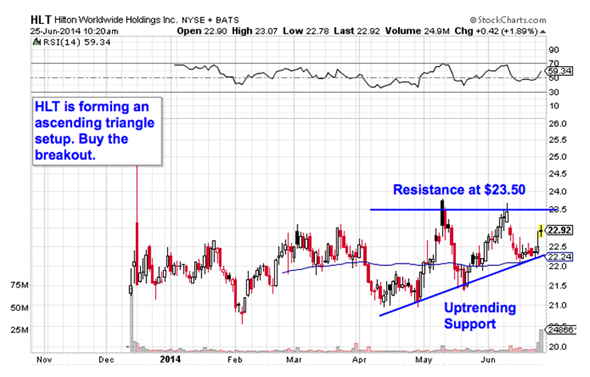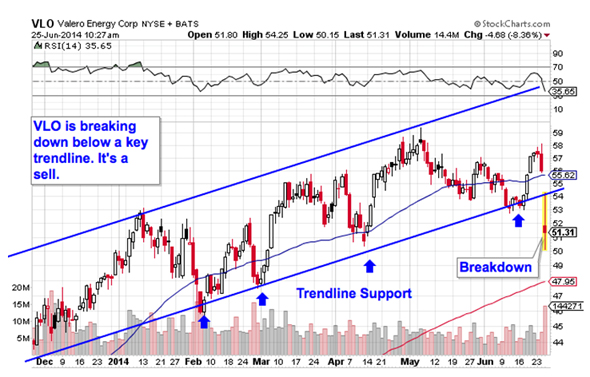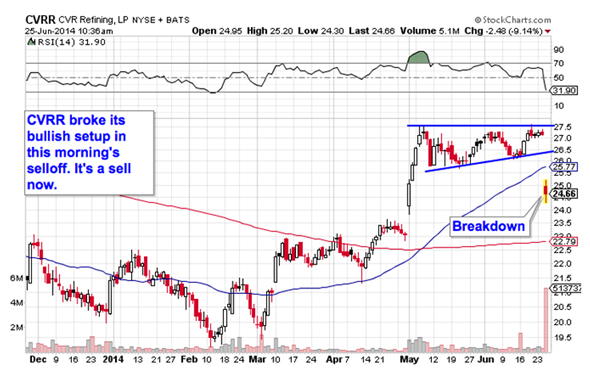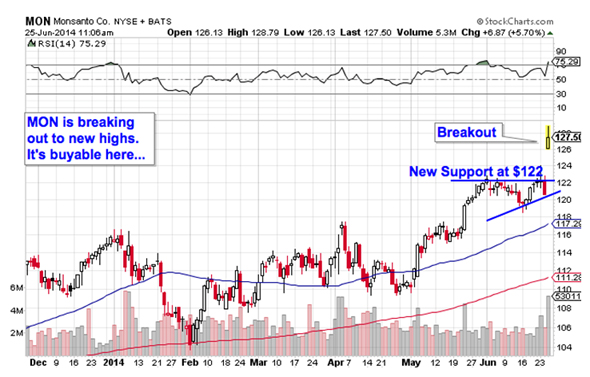DELAFIELD, Wis. (Stockpickr) -- Corporate insiders sell their own companies' stock for a number of reasons.
>>Beat the S&P With 5 Stocks Everyone Else Hates
They might need the cash for a big personal purchase such as a new house or yacht, or they might need the cash to fund a charity. Sometimes they sell as part of a planned selling program that they have put in place for diversification purposes, which allows them to sell stock in stages instead of selling all at one price.
Other times they sell because they think their stock is overvalued and the risk/reward is no longer attractive. Some even dump their own stock because they have inside knowledge that a competitor is eating their lunch and stealing market share.
But insiders usually buy their own shares for one reason: They think the stock is a bargain and has tremendous upside.
>>5 Hated Earnings Stocks You Should Love
The key word in that last statement is "think." Just because a corporate insider thinks his or her stock is going to trade higher, that doesn't mean it will play out that way. Insiders can have all the conviction in the world that their stock is a buy, but if the market doesn't agree with them, the stock could end up going nowhere. Also, I say "usually" because sometimes insiders are loaned money by the company to buy their own stock. Those loans are often sweetheart deals and shouldn't be viewed as organic insider buying.
At the end of the day, it's large institutional money managers running big mutual funds and hedge funds that drive stock prices, not insiders. That said, many of these savvy stock operators will follow insider buying activity when they agree with the insider that the stock is undervalued and has upside potential. This is why it's so important to always be monitoring insider activity, but it's twice as important to make sure the trend of the stock coincides with the insider buying.
>>5 Stocks Ready for Breakouts
Recently, a number of companies' corporate insiders have bought large amounts of stock. These insiders are finding some value in the market, which warrants a closer look at these stocks. Here's a look five stocks whose insiders have been doing some big buying per SEC filings.
Agco
One industrial player that insiders are snapping up a huge amount of stock in here is Agco (AGCO), which manufactures and distributes agricultural equipment and related replacement parts worldwide. Insiders are buying this stock into notable weakness, since shares are off by 11.7% over the last six months.
Agco has a market cap of $5 billion and an enterprise value of $5.2 billion. This stock trades at a cheap valuation, with a trailing price-to-earnings of 9 and a forward price-to-earnings of 10.19. Its estimated growth rate for this year is -8%, and for next year it's pegged at -4%. This is not a cash-rich company, since the total cash position on its balance sheet is $1.05 billion and its total debt is $1.25 billion. This stock currently sports a dividend yield of 0.8%.
>>3 Stocks Under $10 Making Big Moves
A director just bought 253,747 shares, or about $13.17 million worth of stock, at $51.91 per share. That same director also just bought 155,592 shares, or about $8.08 million worth of stock, at $51.94 per share.
From a technical perspective, AGCO is currently trending above its 50-day moving average and below its 200-day moving averages, which is neutral trendwise. This stock has been uptrending a bit over the last two months, with shares moving higher from its low of $49.82 to its recent high of $54.61 a share. During that move, shares of AGCO have been making mostly higher lows and higher highs, which is bullish technical price action. Shares of AGCO are now starting to move within range of triggering a near-term breakout trade.
If you're bullish on AGCO, then I would look for long-biased trades as long as this stock is trending above its 50-day at $52.83 or above more support at $51.71 and then once breaks out above some near-term overhead resistance levels at $54.61 to its 200-day moving average of $56.21 a share with high volume. Look for a sustained move or close above those levels with volume that hits near or above its three-month average action of 1.43 million shares. If that breakout kicks off soon, then AGCO will set up to re-test or possibly take out its next major overhead resistance levels $59.29 to $61.26 a share.
Novavax
A biotechnology player that insiders are active in here is Novavax (NVAX), which focuses on developing recombinant protein nanoparticle vaccines to address a range of infectious diseases. Insiders are buying this stock into weakness, since shares are down by 9% so far in 2014.
>>3 Hot Stocks to Trade (or Not)
Novavax has a market cap of $970 million and an enterprise value of $845 million. This stock trades at a premium valuation, with a price-to-sales of 44.69 and a price-to-book of 4.60. Its estimated growth rate for next year is 12.9%. This is a cash-rich company, since the total cash position on its balance sheet is $133.07 million and its total debt is just $2.18 million.
A director just bought 50,000 shares, or about $216,000 worth of stock, at $4.33 per share. Another director also just bought 25,000 shares, or about $111,000 worth of stock, at $4.47 per share.
From a technical perspective, NVAX is currently trending below its 50-day moving average and above its 200-day moving average, which is neutral trendwise. This stock has been downtrending over the last month, with shares moving lower from its high of $6.95 to its recent low of $3.94 a share. During that move, shares of NVAX have been consistently making lower highs and lower lows, which is bearish technical price action. That said, shares of NVAX have now started to rebound higher off its 200-day and the stock could be putting in a bottom here.
If you're in the bull camp on NVAX, then I would look for long-biased trades as long as this stock is trending above its 200-day at $3.81 and then once it breaks out above some near-term overhead resistance at $5 to its 50-day moving average at $5.72 a share with high volume. Look for a sustained move or close above those levels with volume that hits near or above its three-month average action of 5.09 million shares. If that breakout starts soon, then NVAX will set up to re-test or possibly take out its next major overhead resistance levels at $6.65 to its 52-week high at $6.95 a share.
Oramed Pharmaceuticals
One pharmaceutical player that insiders are in love with here is Oramed Pharmaceuticals (ORMP), which is engaged in the research and development of pharmaceutical solutions for the use of orally ingestible capsules or pills for delivery of polypeptides. Insiders are buying this stock into major weakness, since shares are down by 26% so far in 2014.
>>3 Biotech Stocks Under $10 to Trade for Breakouts
Oramed Pharmaceuticals has a market cap of $110 million and an enterprise value of $93 million. This stock trades at a fair valuation, with a forward price-to-earnings of 24.09. Its estimated growth rate for next year is 167.6%. This is a cash-rich company, since the total cash position on its balance sheet is $7.79 million and its total debt is just $47,250.
A beneficial owner just bought 75,000 shares, or about $796,000 worth of stock, at $10.62 per share.
From a technical perspective, ORMP is currently trending above its 200-day moving average and below its 50-day moving average, which is neutral trendwise. This stock has been downtrending badly for the last three months, with shares falling from its high of $31.73 to its recent low of $9.64 a share. During that move, shares of ORMP have been making mostly lower highs and lower lows, which is bearish technical price action. That said, shares of ORMP have now started to bounce off its 200-day and it's quickly moving within range of triggering a near-term breakout trade.
If you're bullish on ORMP, then I would look for long-biased trades as long as this stock is trending above its 200-day at $10.23 or above more support at $9.64 and then once it breaks out above some near-term overhead resistance levels at $12 to $12.50 a share with high volume. Look for a sustained move or close above that level with volume that hits near or above its three-month average action of 787,203 shares. If that breakout triggers soon, then ORMP will set up to re-test or possibly take out its next major overhead resistance levels at $14 to $15, or even its 50-day moving average of $16.37 a share.
Equinix
One technology player that insiders are loading up on here is Equinix (EQIX), which provides data center services to protect and connect the information assets for the enterprises, financial services companies and content and network providers primarily in the Americas, Europe, the Middle East, Africa and the Asia-Pacific. Insiders are buying this stock into modest strength, since shares are up 3.6% so far in 2014.
>>2 Big Tech Stocks Bouncing Higher
Equinix has a market cap of $9 billion and an enterprise value of $12 billion. This stock trades at fair valuation, with a trailing price-to-earnings of 96.89 and a forward price-to-earnings of 31.96. Its estimated growth rate for this year is 88.9%, and for next year it's pegged at 60.5%. This is not a cash-rich company, since the total cash position on its balance sheet is $631.70 million and its total debt is $4.16 billion.
A beneficial owner just bought 325,000 shares, or about $58.56 million worth of stock, at $180.19 per share.
From a technical perspective, EQIX is currently trending above its 200-day moving average and just below its 50-day moving average, which is neutral trendwise. This stock has been trending lower over the last month and change, with shares moving down from its high of $196.20 to its recent low of $178.69 a share. That downtrend stopped right around EQIX's 200-day moving average and the stock has now started to bounce higher off that level. That bounce is starting to push shares of EQIX within range of triggering a near-term breakout trade.
If you're bullish on EQIX, then I would look for long-biased trades as long as this stock is trending above its 200-day at $177.71 and then once it breaks out above is 50-day at $185.86 a share with high volume. Look for a sustained move or close above that level with volume that hits near or above its three-month average volume of 942,905 shares. If that breakout materializes soon, then EQIX will set up to re-test or possibly take out its next major overhead resistance levels at $192.50 to $196.20 a share.
Chesapeake Energy
One final stock with some big insider buying is Chesapeake Energy (CHK), which is engaged in the acquisition, exploration and development of properties for the production of natural gas, oil and natural gas liquids from underground reservoirs in the U.S. Insiders are buying this stock into modest weakness, since shares are down by 7% over the last three months.
Chesapeake Energy has a market cap of $16 billion and an enterprise value of $29 billion. This stock trades at a reasonable valuation, with a trailing price-to-earnings of 34.81 and a forward price-to-earnings of 11.81. Its estimated growth rate for this year is 26.7%, and for next year it's pegged at 12.6%. This is not a cash-rich company, since the total cash position on its balance sheet is $837 million and its total debt is a whopping $13.02 billion. This stock currently sports a dividend yield of 1.4%.
A director just bought 54,250 shares, or about $1.35 million worth of stock, at $24.97 per share.
From a technical perspective, CHK is currently trending below both its 50-day and 200-day moving averages, which is bearish. This stock recently formed a double bottom chart pattern at $23.92 to $24.24 a share. Following that bottom, shares of CHK have started to uptrend a bit and the stock is now moving within range of triggering a near-term breakout trade.
If you're bullish on CHK, then look for long-biased trades as long as this stock is trending above some key near-term support levels at $24.24 to $23.92 and then once it breaks out above its 50-day moving average of $25.72 a share to more resistance at $26.28 a share with high volume. Look for a sustained move or close above those levels with volume that hits near or above its three-month average action of 9.73 million shares. If that breakout gets underway soon, then CHK will set up to re-test or possibly take out its next major overhead resistance levels $27.46 to $27.73 a share. Any high-volume move above those levels will then give CHK a chance to challenge its 52-week high at $29.06 a share.
To see more stocks with notable insider buying, check out the Stocks With Big Insider Buying portfolio on Stockpickr.
-- Written by Roberto Pedone in Delafield, Wis.
RELATED LINKS:
>>5 Stocks Set to Soar on Bullish Earnings
>>5 Toxic Stocks to Sell Now
>>5 Rocket Stocks to Buy as Stocks Test New Highs
Follow Stockpickr on Twitter and become a fan on Facebook.
At the time of publication, author had no positions in stocks mentioned.
Roberto Pedone, based out of Delafield, Wis., is an independent trader who focuses on technical analysis for small- and large-cap stocks, options, futures, commodities and currencies. Roberto studied international business at the Milwaukee School of Engineering, and he spent a year overseas studying business in Lubeck, Germany. His work has appeared on financial outlets including
CNBC.com and Forbes.com. You can follow Pedone on Twitter at www.twitter.com/zerosum24 or @zerosum24.



